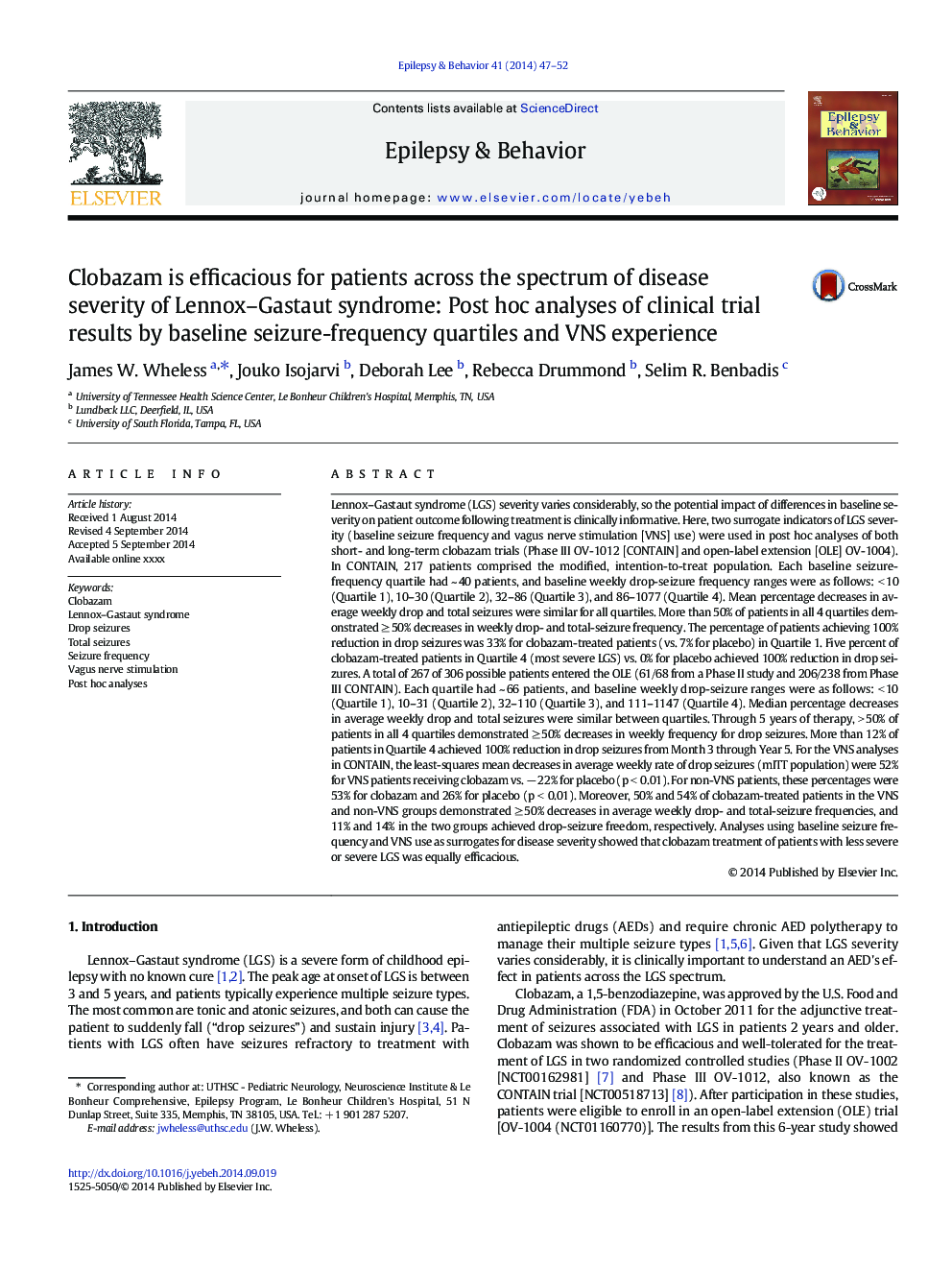| کد مقاله | کد نشریه | سال انتشار | مقاله انگلیسی | نسخه تمام متن |
|---|---|---|---|---|
| 6011776 | 1579848 | 2014 | 6 صفحه PDF | دانلود رایگان |
عنوان انگلیسی مقاله ISI
Clobazam is efficacious for patients across the spectrum of disease severity of Lennox-Gastaut syndrome: Post hoc analyses of clinical trial results by baseline seizure-frequency quartiles and VNS experience
دانلود مقاله + سفارش ترجمه
دانلود مقاله ISI انگلیسی
رایگان برای ایرانیان
کلمات کلیدی
موضوعات مرتبط
علوم زیستی و بیوفناوری
علم عصب شناسی
علوم اعصاب رفتاری
پیش نمایش صفحه اول مقاله

چکیده انگلیسی
Lennox-Gastaut syndrome (LGS) severity varies considerably, so the potential impact of differences in baseline severity on patient outcome following treatment is clinically informative. Here, two surrogate indicators of LGS severity (baseline seizure frequency and vagus nerve stimulation [VNS] use) were used in post hoc analyses of both short- and long-term clobazam trials (Phase III OV-1012 [CONTAIN] and open-label extension [OLE] OV-1004). In CONTAIN, 217 patients comprised the modified, intention-to-treat population. Each baseline seizure-frequency quartile had ~ 40 patients, and baseline weekly drop-seizure frequency ranges were as follows: < 10 (Quartile 1), 10-30 (Quartile 2), 32-86 (Quartile 3), and 86-1077 (Quartile 4). Mean percentage decreases in average weekly drop and total seizures were similar for all quartiles. More than 50% of patients in all 4 quartiles demonstrated â¥Â 50% decreases in weekly drop- and total-seizure frequency. The percentage of patients achieving 100% reduction in drop seizures was 33% for clobazam-treated patients (vs. 7% for placebo) in Quartile 1. Five percent of clobazam-treated patients in Quartile 4 (most severe LGS) vs. 0% for placebo achieved 100% reduction in drop seizures. A total of 267 of 306 possible patients entered the OLE (61/68 from a Phase II study and 206/238 from Phase III CONTAIN). Each quartile had ~ 66 patients, and baseline weekly drop-seizure ranges were as follows: < 10 (Quartile 1), 10-31 (Quartile 2), 32-110 (Quartile 3), and 111-1147 (Quartile 4). Median percentage decreases in average weekly drop and total seizures were similar between quartiles. Through 5 years of therapy, > 50% of patients in all 4 quartiles demonstrated â¥Â 50% decreases in weekly frequency for drop seizures. More than 12% of patients in Quartile 4 achieved 100% reduction in drop seizures from Month 3 through Year 5. For the VNS analyses in CONTAIN, the least-squares mean decreases in average weekly rate of drop seizures (mITT population) were 52% for VNS patients receiving clobazam vs. â 22% for placebo (p < 0.01). For non-VNS patients, these percentages were 53% for clobazam and 26% for placebo (p < 0.01). Moreover, 50% and 54% of clobazam-treated patients in the VNS and non-VNS groups demonstrated â¥Â 50% decreases in average weekly drop- and total-seizure frequencies, and 11% and 14% in the two groups achieved drop-seizure freedom, respectively. Analyses using baseline seizure frequency and VNS use as surrogates for disease severity showed that clobazam treatment of patients with less severe or severe LGS was equally efficacious.
ناشر
Database: Elsevier - ScienceDirect (ساینس دایرکت)
Journal: Epilepsy & Behavior - Volume 41, December 2014, Pages 47-52
Journal: Epilepsy & Behavior - Volume 41, December 2014, Pages 47-52
نویسندگان
James W. Wheless, Jouko Isojarvi, Deborah Lee, Rebecca Drummond, Selim R. Benbadis,